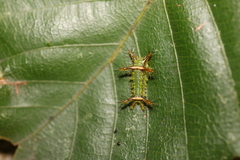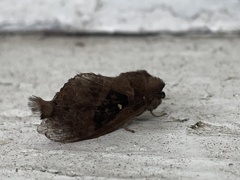Limacodidae: taxon details and analytics
- Domain
- Kingdom
- Animalia
- Phylum
- Arthropoda
- Class
- Insecta
- Order
- Lepidoptera
- Family
- Limacodidae
- Genus
- Species
- Scientific Name
- Limacodidae
Summary description from Wikipedia:
Limacodidae
The Limacodidae or Eucleidae are a family of moths in the superfamily Zygaenoidea or the Cossoidea; the placement is in dispute. They are often called slug moths because their caterpillars bear a distinct resemblance to slugs. They are also called cup moths because of the shape of their cocoons.
The larvae are often liberally covered in protective stinging hairs, and are mostly tropical, but occur worldwide, with about 1800 described species and probably many more as yet undescribed species.
...Limacodidae in languages:
- Afrikaans
- Brandruspes
- Chinese
- 刺蛾科
- Czech
- slimákovcovití
- Danish
- Sneglespindere
- English
- Slug Caterpillar Moths
- English
- Slug Caterpillars
- English
- Cup Moths
- English
- saddleback caterpillars
- Estonian
- kakandkedriklased
- Finnish
- etanaperhoset
- German
- Schneckenspinner
- German
- Asselspinner
- German
- Schildmotten
- Japanese
- イラガ科
- Korean
- 쐐기나방과
- Portuguese
- Mariposas-lesmas
- Russian
- Слизневидки
- Russian
- Бабочки-мокрицы
- Swedish
- snigelspinnare
- Thai
- วงศ์ หนอนร่าน
- Thai
- วงศ์ ผีเสื้อหนอนร่าน
- Ukrainian
- Слизневидки
Images from inaturalist.org observations:
We recommend you sign up for this excellent, free service.
Parent Taxon
Sibling Taxa
Child Taxa
- Afronarosa
- Afroplax
- Allothosea
- Ambaliha
- Anaxidia
- Andaingo
- Anepopsia
- Anilina
- Ankijabe
- Apodecta
- Apreptophanes
- Atosioides
- Avatara
- Baria
- Barilla
- Beggina
- Boisduvalodes
- Bornethosea
- Brachia
- Brachiopsis
- Brachypecta
- Calauta
- Calcarifera
- Casphalia
- Chalcoscelis
- Chrysopolomides
- Chrysopolominae
- Claphidia
- Collenettea
- Comana
- Comanula
- Compactena
- Compsopsectra
- Deltoptera
- Doratifera
- Eccopa
- Ecnomoctena
- Ectropa
- Eloasa
- Erotomania
- Erythropteryx
- Eukarschia
- Exanthica
- Featheria
- Fletcherodes
- Gyroptera
- Hadraphe
- Hedraea
- Hegetor
- Hepialopsis
- Heringana
- Heringarosa
- Heringocena
- Heringodes
- Heuretes
- Hilipoda
- Hindothosea
- Homosusica
- Hydroclada
- Hyphormides
- Inous
- Isozinara
- Lamprolepida
- Lembopteris
- Lemuria
- Lemuricomes
- Leucophobetron
- Limacodinae
- Limacolasia
- Limacosilla
- Limantricodes
- Macrosemyra
- Malgassica
- Malgassica
- Malgassica
- Mambarilla
- Mambarona
- Mandoto
- Marmorata
- Marsuplectra
- Mecytha
- Microphobetron
- Monopecta
- Narosopsis
- Neiraga
- Neogavara
- Neomocena
- Oidemaskelis
- Omocena
- Omocenops
- Omocenops
- Paleophobetron
- Paraclea
- Paragetor
- Paraplectra
- Parasoidea
- Paryphantina
- Phlebodicha
- Phorma
- Platyprosterna
- Praesusica
- Probalintha
- Prolatoia
- Prosternidia
- Pseudanapaea
- Pseudolatoia
- Pseudomocena
- Pseudonagoda
- Pseudothosea
- Psythiarodes
- Pygmaeomorpha
- Saccurosa
- Scotinochroa
- Semibirthama
- Setothosea
- Sisyrosea
- Strigivenifera
- Stroteroides
- Sundarosa
- Susicina
- Teinorhyncha
- Tetraphleba
- Thliptocnemis
- Thoseidea
- Trachyptena
- Ulamia
- Unipectiphora
- Vietteiola
- Vietteopoloma
- Ximacodes
- Zaparasa
- Zarachella
- Zinara
- Zorostola
Top Observation Places
- San José
- Nagoya
- Bogor
- Thiruvananthapuram
- Brisbane
- Cheonan
- Bengaluru
- Yogyakarta
- Melati
- Gamping Lor
- Godean
- Sleman
- Mumbai
- Thāne
- Taipei
- Banqiao
- Neihu
- Shulin
- Queenstown Estate
- Shenzhen
- Hong Kong
- Kowloon
- Victoria
- Tuen Mun
- Sha Tin
- Tseung Kwan O
- Kwai Chung
- Tsuen Wan
- Tin Shui Wai
- Tai Po
- Fanling
- Ma On Shan
- Tsing Yi Town
- Yuen Long Kau Hui
- Aberdeen
- Tung Chung
- Pok Fu Lam































































































































































